- In 1990 about 417,000 Americans died of smoking-related illnesses.
- Nearly one-fifth of deaths from cardiovascular diseases are attributable to smoking. It's also estimated that about 37,000 -- 40,000 nonsmokers die each year from cardiovascular diseases as a result of exposure to environmental tobacco smoke.
- Smoking-related illnesses cost about $50 billion annually in medical care.
- Studies show that among people age 18 and older in the United States, smoking has declined by about 40 percent since 1965, although recent data indicate that this downward trend may have leveled off.
Age, Sex
- Every day 3,000 American young people become smokers, according to estimates by the Centers for Disease Control and Prevention.
- 75 percent of adult smokers started before age 18 and 90 percent began before they were 21, according to Centers for Disease Control and Prevention estimates.
- 43 percent of American children ages two months to 11 years are exposed to environmental tobacco smoke in the home.
- Current estimates are that 26.0 million men (28.2 percent) and 23.1 million women (23.1 percent) in the U.S. are smokers, putting them at increased risk of heart attack. In addition, an estimated 2.2 million adolescents ages 12 -- 17 are smokers.
- The World Health Organization reports that 20 -- 35 percent of women in developed nations smoke compared with 2 -- 10 percent of those in the developing nations.
- Studies show that women smokers who use oral contraceptives are much more likely to have a heart attack and much more likely to have a stroke than women who neither smoke nor use birth control pills.
- Studies show that smoking prevalence is several times higher among those with less than 12 years of education compared to those with more than 16 years of education.
- 47.7 percent of working adults who are 17 years old or older and do not use tobacco reported exposure to environmental tobacco smoke at home or at work.
- Of adults who don't use tobacco, 37.4 percent reported exposure to environmental tobacco smoke at home or at work.
- The risk of death from coronary heart disease increases by up to 30 percent among those exposed to environmental tobacco smoke at home or at work.
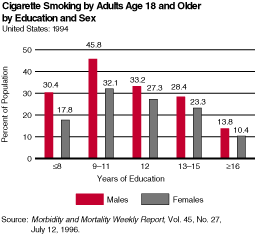 | 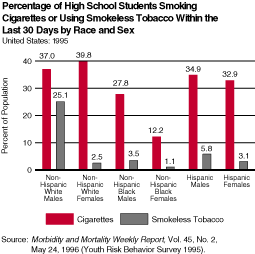 |
An estimated 97.2 million American adults (52.1 percent) have blood cholesterol levels of 200 milligrams per deciliter (mg/dL) and higher, and about 38.3 million American adults (20.5 percent) have levels of 240 mg/dL or above.*
- About 36.5 percent of American youth age 19 and under (27.4 million young people) have blood cholesterol levels of 170 mg/dL or higher. (This is comparable to a level of 200 mg/dL in adults.)
- 13.0 million boys and 14.4 million girls age 19 and under have blood cholesterol levels of 170 mg/dL or higher.
- Studies done on people age 20 and older show that women's cholesterol is higher than men's beginning at age 55.
- Before age 45, the range of means for total blood cholesterol of women is from 185 -- 207 mg/dL, but between ages 45 and 64, the range rises to between 217 and 237 mg/dL.
- Among elderly Japanese-American men in the Honolulu Heart Program Fourth Examination (1991 -- 93), 42 percent had cholesterol levels greater than or equal to 200 mg/dL or were taking cholesterol-lowering medication.
*Centers for Disease Control and National Center for Health Statistics: Unpublished and published data from Phase I, National Health and Nutrition Examination Survey III (NHANES III), 1988 -- 91 and the American Heart Association.
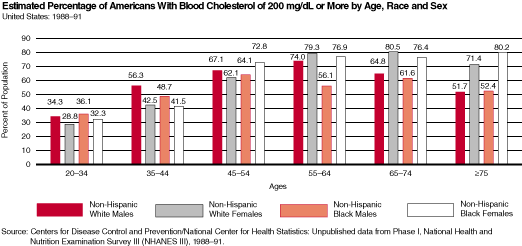 | |
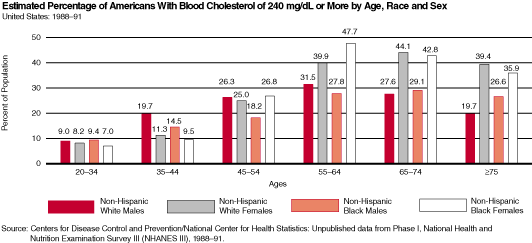 | |
- About 22 percent of American adults report regular sustained physical activity of any intensity lasting 30 minutes or more five times a week.
- About 15 percent of U.S. adults engage in regular vigorous physical activity three times a week for at least 20 minutes.
- About 25 percent of Americans age 18 or older report no leisure-time physical activity.
- 1994 Behavioral Risk Factor Surveillance Survey (BRFSS) state data show that 60 percent or more of adults did not achieve the recommended amount of physical activity, and in half of the states 73 percent or more of adults were not active enough.
- People with lower incomes and less than a 12th grade education are more likely to be sedentary.
- The relative risk of coronary heart disease (heart attack) associated with physical inactivity ranges from 1.5 to 2.4, an increase in risk comparable with that observed for high cholesterol, high blood pressure or cigarette smoking.
- Less active, less fit persons have a 30 -- 50 percent greater risk of developing high blood pressure.
- As many as 250,000 deaths per year in the United States -- about 12 percent of total deaths -- are attributed to a lack of regular physical activity.
<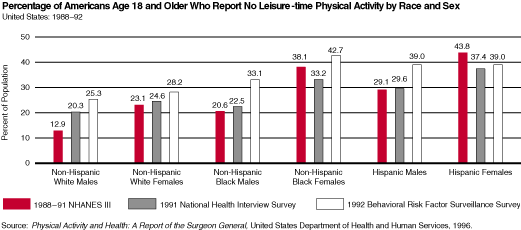 |
Age, Sex
- Nearly half of American youth ages 12 -- 21 are not vigorously active on a regular basis. Physical activity declines dramatically during adolescence.
- Daily enrollment in Physical Education classes has declined among high school students from 42 percent in 1991 to 25 percent in 1995.
- Only 19 percent of all high school students are physically active for 20 minutes or more in physical education classes every day during the school week.
- A 1996 report of physical Activity showed the number of Americans age 18 and older who reported no physical activity was 15.8 percent of men and 27.1 percent of women.
- The percentage of adults ages 65 -- 74 and 75 and older who reported no leisure time physical activity in 1992 was 33.2 percent and 38.2 percent for men and 36.6 percent and 50.5 percent for women, respectively. In 1988 -- 91, it was 17.5 percent and 34.5 percent for men and 32.5 and 54.3 percent for women, respectively.
Based upon 1988 -- 91 data, nearly 62 million American adults (28.1 million men and 33.9 million women) are 20 percent or more above their desirable weight, an increase of 36 percent over 1960 -- 62 examination data.
- 33 percent of overweight men and 41 percent of overweight women are not physically active during their leisure time.
- Data show the prevalence of overweight among American adolescents age 12 to 19 to be 21 percent (20 percent for males and 22 percent for females).
- Among native Hawaiians, 65.5 percent of males and 62.6 percent of females are overweight.
Diabetes killed 55,390 Americans in 1994. 1993 final mortality: males -- 23,430 deaths (43.5 percent of total deaths from diabetes); females -- 30,464 (56.5 percent of total deaths from diabetes).
- 7,800,000 Americans have diabetes (3.6 million males and 4.2 million females).
- 625,000 new cases of diabetes are diagnosed every year.
- 502,000 Americans diagnosed with diabetes mellitus were discharged from hospitals in 1994. Of these, 223,000 were males and 279,000 were females.
- More than 80 percent of people with diabetes mellitus die of some form of heart or blood vessel disease.
- In the 1991 -- 93 phase of the Honolulu Heart Program, 17 percent of Japanese-American men ages 71 -- 93 had diabetes. In addition, 19 percent had unrecognized diabetes and 32 percent had impaired glucose tolerance.
http://www.fauxpress.com/kimball/med/heart/h2/coron.riskf.htm

Комментариев нет:
Отправить комментарий